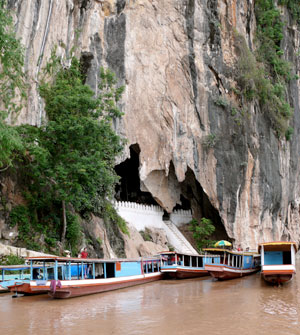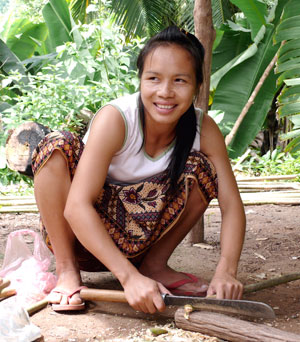LUANG PRABANG, LAOS - A favourite day outing with tourists who come to this remote part of Asia is to take a boat ride down the murky Mekong River - its waters are the colour of a cup of mocha coffee - to the artisan village of Lao Lao and then on to the Pac Cu, or Buddha caves.
So, we headed out one cloudy morning on a long tail boat with a young captain and his family - they live in a compartment at the back of the vessel. The voyage takes two hours to reach the Pac Cu caves, the natural rock cavity filled with Bhudda statues, put their by order of a 16th century king. However, the return journey to Luang Prabang is cut in half because the captain is able to ride the river's strong current.


Left: Mekong caves are filled with statues. Right: A young woman works at a village along the Mekong River.
Along the way we are treated to glimpses at life deep inside Laos, one of the best-kept secrets in tourism. The shoreline at this point of the mighty Makong is dramatic, with mountains jutting up through low-lying clouds.
Village children entertained the "big nose foreigners" by jumping off tree branches into the river and yelled "hello" as the boat slowly drifted past. Fishermen cast their lines into the water but shied away when we asked if we could take their photographs.
About an hour into the voyage we reached Lao Lao, the arts and crafts village famous for producing the country's potent rice wine. An old woman washing a basket of rice in the river greeted us with a toothless smile and seemed to enjoy the attention she was getting from the photo-hungry tourists.
Our guide Kip led us up some steep steeps from the makeshift dock into the village where artisans were selling scarves and other clothing produced on ancient looms. One member of our tour asked if the items were handmade.
Kip just laughed and replied: "This is one country where you are almost certain that items are handmade because there are very few machines to make anything."
Everyone in our group asked to sample the rice wine - that's when we heard a yell coming from a kiosk up ahead.
A frightened American woman came running back to the group with news that there was something very unusual in the rice wine bottles. The villagers were doubled over in laughter at seeing the woman's reaction something they no doubt had seen many times before.
The rest of us were equally shocked when we got to hold the bottles, each one of which contained a large dead scorpion, snake or lizard.
"The insects give the wine a very special taste," explained Kip.
Suddenly, no one in our group wanted to taste the wine.
As we boarded the boat to continue our voyage upstream we saw chickens and pigs fighting over the discarded rice.
"The animals actually get drunk on what's thrown away," said Kip.
"They'd better watch out or they'll end up in the bottle," I observed.
The limestone rock that covers the exterior of Pac Cu caves can be seen long before the boats reach the rickety dock where half a dozen flat boats are usually moored. Our captain expertly pulled alongside and we then made our way up another set of steep stairs to the first of two caves where 4,000 Buddha statues, in all shapes and sizes, had been placed over the centuries.
"There are another 3,000 statues in the cave located above," said Kip. "But we have to walk up 220 steps to reach them."
The oppressive Laotian heat and the steep grade made the climb to the top of Pac Cu a challenge for even the fittest in the group. Along the way, children from a village on the opposite shore tried to sell us small birds in a wicker cage for $1 U.S., which you are supposed to release after purchasing as a good deed.
Laotians, even the poorest, are a proud people and children are encouraged never to beg so they come up with some innovative ways to make money.
"Please never offer the children money unless they sell you something or offer you a service - we never want our children to be beggars," said the proud Kip, who lives in the capital Vientiane.
Upon arrival back in Luang Prabang we headed for a local eatery and enjoyed some traditional dishes - Laotian cuisine consists of simple fish and rice dishes that are spiced with sweet curries and peppers - and a huge bottle of beer that ended up costing each of us less than $10 U.S.
Laotians like to deal in cash and the recently-installed ATM machine in Luang Prabang is only there "for the tourists," said Kip.
The good news for tourists looking to stretch their ever-shrinking travel dollars is that Laos is even cheaper than its inexpensive neighbours Thailand and Cambodia. Rooms in the 5-star Orient Express property cost less than $200 a night in high season and well appointed guest houses located in well-kept colonial structures start at about $40 a night.
Laos is a place that time forgot but that's all about to change. So time is running out to get there before others find it.
About the Author
Marc Atchison is a veteran journalist and a seasoned traveller with more than 20 years of travel writing experience. As the former Travel Editor of the Toronto Star, Canada's largest newspaper, and now Editor-in-Chief and Senior Writer for TraveLife magazine (Canada) and travelife.ca, Marc has been to over 100 countries in the world. Japan is one of his favorite destinations and he's been there on numerous occasions.